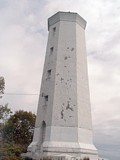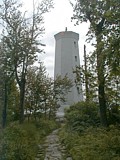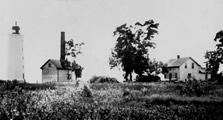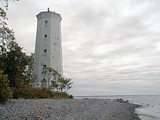
"In Beautiful
Brighton, Ontario"

Presqu'ile Point Lighthouse


Outside Brighton, Ontario along the beautiful shoreline of Lake Ontario is... almost an island. And on this almost an island is a 69 foot lighthouse called Presqu'ile Point Lighthouse. The lighthouse, which is situated at the eastern most point of the peninsula, was built in 1840. Originally being built out of poor quality stone the building started to deteriorate which led to it being strengthened with a wooden frame and protected with cedar shakes in 1894. Over the years the lighthouse has been converted to electricity and the cupola was removed and replaced with a beacon. For the most part the lighthouse remains unchanged and has become the second oldest lighthouse along the shores of Lake Ontario.
The Presqu'ile Point Lighthouse is a great sight to see within beautiful Presqu'ile Provincial Park. It costs $12 for a daily vehicle permit while you can Bike and Walk for free. Within the park are many campsites as well as sights to see. There are beaches, trails and even an extensive marshland boardwalk trail which are protected for generations to come thanks to the Friends of Presqu'ile Park organization. Many bird species as well as Monarch Butterflies migrate through Presqu'ile Park which makes it a great places for bird watching. As you travel through the park you eventually come to the lighthouse and interpretive center on the point of the peninsula. The point is a great place for a picnic along the shoreline with flat skip worthy rocks littering the shoreline. Although the lighthouse is a great place for a visit it is just one of many sights to see in the naturally and culturally unique Presqu'ile (French for Almost Island) Park.

Lighthouse History
Presqu'ile (French for "almost an island") Point, near Brighton, Ontario, is roughly halfway between Toronto and Kingston. In 1795, John Graves Simcoe, first Lieutenant-Governor of Upper Canada, ordered the peninsula of Presqu'ile surveyed in preparation for a future townsite. Presqu'ile Peninsula is the first intrusion of land encountered by vessels traveling from York (now Toronto) along the northern shore of Lake Ontario. A harbor at Presqu'ile would allow shipping to pass through the protected Bay of Quinte (by crossing a short portage linking the Prince Edward Peninsula with the mainland) and avoid the more hazardous route around the Prince Edward Peninsula.

In the early 1800's, the peninsula was to be the site of the capital of Northumberland and Durham Counties - "Newcastle." In 1804, a the first trial was to be held at the first public building at the site - a courthouse. An Ojibway Indian named Ogetonicut was arrested near York (now Toronto) for the murder of a fur trader, John Sharp. On October 7, 1804, the schooner Speedy sailed from York bound for Presqu'ile. The schooner carried the prisoner and several high-ranking officials involved in the trial. On October 8th, the Speedy was seen briefly off Presqu'ile, and then was lost with all hands. "The loss of so many prominent persons was a severe blow to the small colony" (Plaque at Presqu'ile).
A report shortly after the loss of the Speedy describe the Newcastle location as "inconvenient" - the site was isolated and the harbor could be difficult to access. Amherst (now Cobourg) became the district town. The Newcastle site was abandoned.
By 1840, Upper Canada had a population of over 430,000. Lake Ontario served as a terminus for several canals in the 1820's and 1830's. The Welland Canal (1829) bypassed the Niagara River for travel between Lakes Erie and Ontario. The Rideau Canal (1830) linked Kingston and Ottawa. The Erie Canal was linked to Lake Ontario via Oswego, NY. Traffic along Lake Ontario had increased considerably.
In 1837, land was surveyed to construct a lighthouse at Presqu'ile Point. The lighthouse was completed in 1840. The 69 foot tower was designed by Nicol Hugh Baird, who worked on the Rideau Canal. £1000 were budgeted for the project, plus £50 when the contractor was hired. The final report put cost of the lighthouse at £9 under budget, but an extra £100 was paid for lantern room repairs, making the final cost £1150.

Baird specified Kingston Limestone and quarried sand for the tower. The builders, however, cut corners by using local limestone and beach sand. The local limestone proved not a durable as the Kingston variety, and soon began to crack. The rounded beach sand eroded from the mortar. Water leaking from the walls and roof froze in the winter. Continuing expansion and contraction of the water over time damaged the walls such that the entire lighthouse was surrounded by a timber girdle in 1894, and then surrounded by another layer of wooden shingles.
A pair of range lights on the northeastern end of Presqu'ile were installed in 1850-1851. The lights were built at Salt Point and between the current Government dock and Salt Point. The range light keeper's dwelling was in poor condition in 1863 - keeper James Cummins wrote "I found a miserable dwelling, an old log house, a part of it weatherboard, the principle part of it is neither lathered nor plastered... water and ice is our companion." (McShane, p. 24) When the Murray Canal (connecting the Bay of Quinte with Presqu'ile Bay) was constructed between 1882 and 1889, new range lights were installed. Today, small modern steel towers light the sites originally lit by the range lights.

The keeper's residence was completed in 1846. There is some discussion over where the first keeper, William Swetman, and his family resided in the cold Ontario winters before the cottage was completed - they may have lived in a tent nearby, or inside the base of the lighthouse! Keeper Swetman served Presqu'ile until his death in 1871, and was succeeded by his son.
A fog signal building was added in 1906. The fog signal was a compressed-air system which served until it was replaced by an electrical system. The fog signal building was torn down in 1948. Only the concrete foundation is visible today.
The lighthouse was equipped with reflectors by 1874. A seventh-order optic was installed in 1896, which was upgraded to fourth-order in 1908.
Presqu'ile was a haven for squatters. In the late 1800's the lighthouse keeper was given the additional responsibility of protecting the timber of Presqu'ile. Deforestation of the peninsula was jeopardizing the sheltered harbor provided by Presqu'ile Bay. In 1871, the Federal government granted land leases to nineteen squatters who agreed not to cut any timber. The lighthouse keeper, as the only government presence on Presqu'ile, was responsible for enforcing this agreement. It is in part due to the lighthouse keepers that many of the trees of Presqu'ile Provincial Park are still standing.

The light was electrified in 1935, and automated in 1952. The lantern room was removed and currently displays a red 500-watt modern optic. The lighthouse still serves as an aid to navigation. A plaque commemorating the loss of the Speedy was erected in 1959. Today, the area is part of Presqu'ile Provincial Park. The region has become a popular location for camping and recreational boating. The keeper's cottage still stands, and is part of the Lighthouse Interpretive Center, which provides information on the natural history of the region.
References:
The Presqu'ile Lighthouse - Its History and Keepers, McShane pp. 2-3, 5, 9, 24, 27
A History of Presqu'ile, Turner pp. 12-13, 17
Presqu'ile Provincial Park 2000 Newspaper, p. 10
